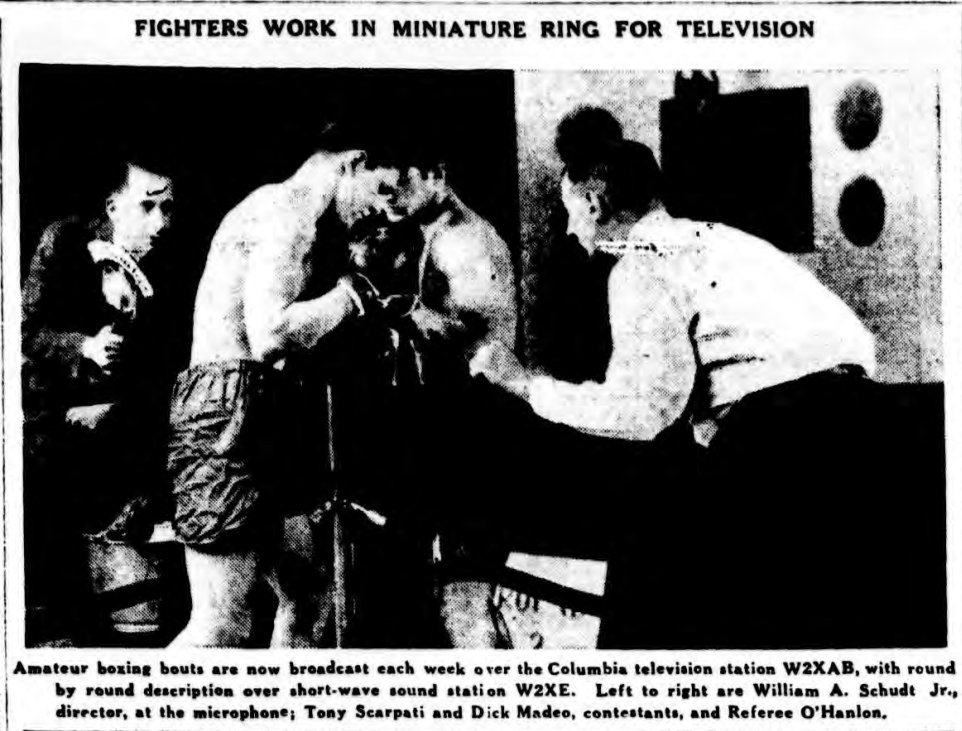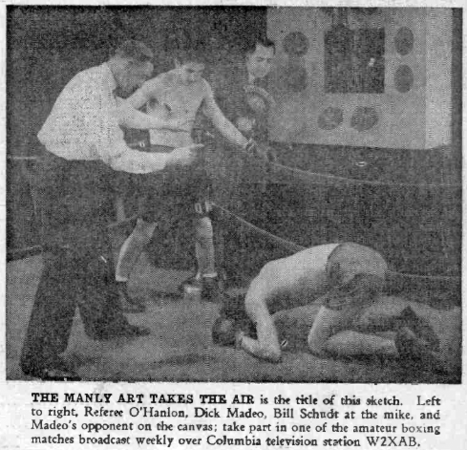Exhibition Boxing Bouts (lost early television coverage of boxing matches; 1931-1932)
Exhibition Boxing Bouts refers to numerous broadcasts made by CBS mechanical television station W2XAB from 1931 to at least 1932. It is notably one of the first sports television programs to ever exist, featuring various boxers pitted against one another in exhibition fights.
Background
In 1931, CBS successfully gained a licence to provide television coverage during an experimental era where mechanical televisions were still the norm.[1] Broadcasting began on 21st July 1931, but most CBS higher-ups aimed to utilise the station, named W2XAB, to promote its radio network including flagship New York radio station WABC.[2][1] Indeed, the station often simply provided a video extension for programs whose audio would air on national radio.[1] Nevertheless, under the hands of Program Director Bill Schudt and Engineer Harry Spears, numerous experimental programs like The Television Ghost were aired.[3][1] Sports would inevitably be considered too, though the limitations of television back then meant airings were rather crude.[1] For example, when college football games aired on radio, W2XAB would broadcast a program where some tin resembling a football was painted with team names, and could detail plays by moving across a board painted like a pitch via thin wires.[1]
Boxing broadcasts were perhaps more sophisticated than this. In fact, during one of Dr. Ernst Alexanderson's early demonstrations on 16th July 1928, one experiment showed the figures of two men engaged in a boxing match.[4][5] More progress was made in 1929, proving boxing matches could be broadcast on television.[5] Thus, a ring was established within the Columbia Television Studios in New York City, with amateur boxers invited to participate in exhibition bouts.[6][1][5] There would naturally be limitations to the matches themselves; because of the studio's small confounds and miniature ring, as well as the camera's minute range, one could only see the boxers from the waist-up, and they needed to box within an exceptionally small area to avoid moving outside of the camera's field of view.[7][6][1][3][5] Thus a knockdown would result in the falling boxer disappearing off-screen.[1][7] Further, fight announcers and referees would be prone to getting caught up in the action, Schudt admitting he was punched several times while providing commentary outside the ring.[1][6]
Exhibition Boxing Bouts
The broadcasts began in August 1931.[8][5] Under program listings the series was typically referred to as "Exhibition Boxing Bout" or "Three-round exhibition boxing bout".[8][3] Broadcasts typically lasted around 15 minutes.[3] The first ever fight on television pitted former World Lightweight Champion Benny Leonard against the Golden Gloves Featherweight Champion Jimmy Martin.[5] Leonard is considered one of the greatest lightweight boxers in history, having held the World Lightweight Title for eight years between 1917 to 1925.[9][10] After retiring in 1925, he was forced to make a comeback after losing much of his money during the 1929 stock market crash, returning in 1931.[10][9] Leonard would defeat Martin by KO in the third round, then stated his comeback was not in vain during the first ever televised post-match interview, insisting that he "lived clean and fought clean".[5] Another confirmed fight occurred prior to 20th February 1932, as The New York Sun provided a photo showing Tony Scarpati fighting against Dick Madeo.[11][12] According to Schudt, Madeo participated in several matches for the program, gaining experience on how best to fight under the limited space by boxing in circles and remaining within the camera's light ray.[13][7] Another fight featured middleweight boxer Mickey Walker, said to have been broadcast on 25th August 1931 based on a preview by the 20th August issue of Brooklyn Daily Eagle.[14][15]
Overall, the broadcasts received positive reception by most viewers.[8][1][5] The main issue, as noted by writer and viewer James Thurber, was that the picture quality would sometimes dilute, resulting in the fighters seemingly looking as if they were "groping in a fog or chasing each other in a tank of milk."[1][6] To partially counteract this, W2XAB had placed heavy black curtains at the rear of the ring to improve image clarity.[5] Additionally, the addition of white powder to the boxers' hair ensured they could remain visible on camera.[5] According to one observer in Arizona, most viewers stated that they preferred "boxing matches and performances which feature plenty of action."[8][5] This was somewhat affirmed when mail from a Middlebury, Vermont viewer stated the following "Of the six television stations that I receive regularly, yours gives the greatest detail. I have especially enjoyed the dancer and the boxing bouts."[5]
Availability
Ultimately, the matches were televised live in a period where recordings were non-existent outside of seldom-utilised discs.[16] Thus, no broadcasts are known to have survived, although two photos have since resurfaced.[11][8][13]
Gallery
Image
See Also
- Corbett and Courtney Before the Kinetograph (partially found early boxing film; 1894)
- Georges Carpentier vs Ted "Kid" Lewis (lost radio coverage of boxing match; 1922)
- Heavyweight Champ (lost SEGA arcade boxing game; 1976)
- Jack Dempsey vs Billy Miske (lost radio report of boxing match; 1920)
- Johnny Ray vs Johnny Dundee (lost radio coverage of boxing match; 1921)
- Leonard-Cushing Fight (partially found early boxing film; 1894)
- Rocky (lost deleted scenes of boxing drama film; 1976)
- Uncle Slam and Uncle Slam Vice Squad (lost iOS presidential boxing games; 2011)
References
- ↑ 1.00 1.01 1.02 1.03 1.04 1.05 1.06 1.07 1.08 1.09 1.10 1.11 The Origins of Television News in America detailing the launch of W2XAB and how it broadcast boxing matches. Retrieved 21st Dec '22
- ↑ Early Television noting the launch of W2XAB.
- ↑ 3.0 3.1 3.2 3.3 Television listing "Three-round exhibition boxing bout" broadcast on 29th December 1931. Retrieved 21st Dec '22
- ↑ Television detailing a boxing demonstration made during Dr. Alexanderson's demonstrations in 1928. Retrieved 21st Dec '22
- ↑ 5.00 5.01 5.02 5.03 5.04 5.05 5.06 5.07 5.08 5.09 5.10 5.11 The Golden Age of Boxing on Radio and Television detailing the early boxing broadcast experiments in 1928 and 1929, and W2XAB's broadcasts including the Leonard-Martin fight. Retrieved 21st Dec '22
- ↑ 6.0 6.1 6.2 6.3 Sports Journalism summarising W2XAB's broadcasts and their limitations. Retrieved 21st Dec '22
- ↑ 7.0 7.1 7.2 7th August 1932 issue of The New York Times reporting on Schudt's comments surrounding the limitations of television, and noting Madeo appearing in several fights. Retrieved 21st Dec '22
- ↑ 8.0 8.1 8.2 8.3 8.4 The Outlook for Television noting boxing's popularity on television, and providing a photo and a listing of a broadcast. Retrieved 21st Dec '22
- ↑ 9.0 9.1 BoxRec detailing Leonard's fights. Retrieved 21st Dec '22
- ↑ 10.0 10.1 The Fight City detailing the life and career of Leonard. Retrieved 21st Dec '22
- ↑ 11.0 11.1 20th February 1932 issue of The New York Sun providing a photo of Scarpati facing off against Madeo. Retrieved 21st Dec '22
- ↑ BoxerList listing Scarpati's fights. Retrieved 21st Dec '22
- ↑ 13.0 13.1 Photo and description of Madeo securing a knockdown on an opponent. Retrieved 21st Dec '22
- ↑ 20th August 1931 issue of Brooklyn Daily Eagle promoting a match set to feature Mickey Walker.
- ↑ BoxRec listing Walker's fights. Retrieved 21st Dec '22
- ↑ TV Dawn detailing the usage of Phonovision discs, one of the extremely limited means of recording television back in the early-1930s. Retrieved 21st Dec '22

